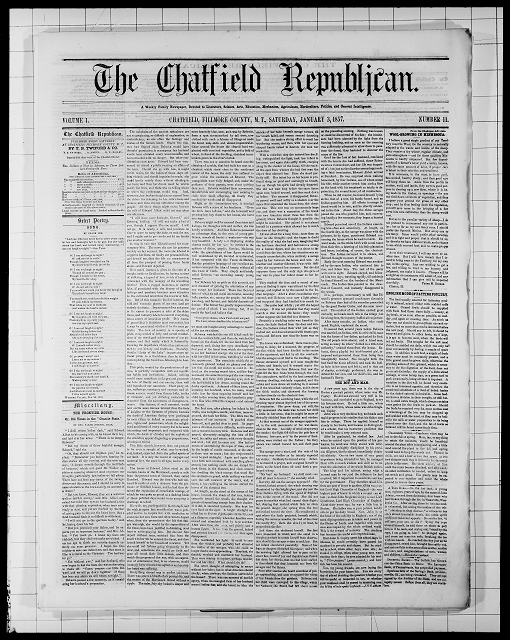The Chatfield Republican
The Chatfield republican (Chatfield, Minn.) 1856-1861 Browse the title
The first issue of the weekly Chatfield Republican was printed in Chatfield, Minnesota on October 25, 1856. It was established by Henry Whitcomb Holley, who moved to Chatfield after working as a civil engineer on railroads in Ohio, Indiana, and Wisconsin. The Republican was the thirty-sixth newspaper published in the Minnesota Territory and the third newspaper published in Fillmore County, located in far southeastern Minnesota, bordering Iowa. Early issues were printed on Saturdays and contained four pages with six columns of text. Holley served as editor, with T. B. Twiford & Co. as publisher; Thomas B. Twiford was another early settler of Chatfield.
As implied by its name, the Chatfield Republican was politically Republican in leaning, and proclaimed itself “devoted to literature, science, arts, education, mechanism, horticulture, politics, and general intelligence”. Poetry, political news, slavery, agricultural and homemaking advice, and local to international news is of focus in the issues. On June 13, 1857, Orville Brown replaced T. B. Twiford and Co. as publisher. In June of 1858 Brown and Holley bought the Faribault Herald, published in Faribault, Minnesota, some 70 miles from Chatfield, and renamed it the Central Republican. On October 31, 1857, the Chatfield Republican switched to printing on Wednesdays and issues were printed with an additional four columns to make the paper “deserving of the patronage”. Sometime in 1859, the Republican again switched its day of print, this time to Tuesdays.

The Chatfield Republican faced political opposition with the debut of the Chatfield Democrat on September 11, 1857. The two papers exchanged critical remarks in the ensuing years. In late 1859, Constance C. Hemphill, editor of the Democrat, sued Holley for libel after the Republican printed a story in the July 2, 1859, issue that implied that Hemphill had stolen items. The judge ruled in Hemphill’s favor and Holley was required to pay Hemphill $100. Reporting on the libel case and on Hemphill’s departure in the December 27, 1859, issue, Holley labeled the jury “partisan.” He acknowledged that the rivalry between the papers was “bitter and often times disgraceful” and wished to “bury the hatchet” with a new editor. Yet, critical remarks continued after the departure of Hemphill.
In addition to arguing against slavery, the Republican was also strongly against the “Five Million Railroad Loan” bill, as Amendment 1 of the Minnesota constitution was known. Ratified on April 15, 1858, this amendment allowed the state legislature to freely loan up to five million dollars to railroad interests. In the March 17, 1858 issue, the paper argued that past cases of fraud by railroad companies were “burlesqued” in the Senate and House of Representatives.
The October 15, 1861 issue was the Chatfield Republican’s last. The paper was sold to J. E. Burbank, who relocated it to Preston, Minnesota, also in Fillmore County, and renamed it the Republican. Holley moved to Winnebago City, Minnesota, and served as a receiver of the public land office. Brown purchased the Mankato Weekly Record in October of 1868. As of 2020 a successor title to the Republican is published in Preston as the Fillmore County Journal.